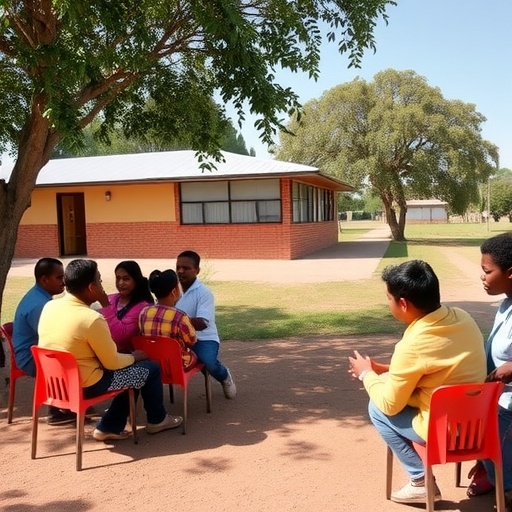
In the rolling landscapes of rural upstate New York, a new study spearheaded by researchers at Cornell University unveils a transformative truth: school-based health centers (SBHCs) embedded directly within the school environment significantly enhance student attendance. This landmark research, the first of its kind focused on rural communities, reveals that children attending schools equipped with these comprehensive health clinics are markedly less likely to suffer from chronic absenteeism compared to their counterparts in districts devoid of such facilities. The findings carry profound implications, not only for educational policy but also for public health strategies aimed at underserved rural populations.
The investigation spanned four counties — Chenango, Delaware, Otsego, and Schoharie — encompassing 52 schools within 32 districts and analyzing attendance data from over 66,000 students between 2015 and 2019. These districts, sharing similar demographics characterized by predominantly white, lower-income families, offered an ideal natural experiment to assess the impact of SBHCs. Approximately 18 schools within the sample hosted clinics operated by a nonprofit hospital system, Bassett Healthcare Network, providing a broad spectrum of physical, mental, and dental health services on-site.
What makes these clinics especially pivotal is their ability to offer immediate, comprehensive medical attention without requiring students to leave campus. The data demonstrated a striking 15% reduction in the risk of chronic absenteeism among students in districts with SBHCs. Chronic absenteeism, defined as missing a significant portion of the school year, has long been associated with adverse academic outcomes and widened health disparities, particularly in rural areas where barriers to healthcare access are pervasive.
Elementary school students saw the most pronounced benefits. In rural contexts, where transportation is limited and medical providers are scarce, the presence of a school-based clinic can mean the difference between a student staying home all day due to a minor ailment or receiving timely treatment and returning to class. By eliminating the need for parents or guardians to disrupt their schedules or find transportation, the clinics directly address logistical hurdles that often prevent children from consistent attendance.
John Sipple, a professor of global development at Cornell and lead author of the study published in JAMA Network Open, emphasized the transformative effect these clinics exert on day-to-day student life. “Rather than the school nurse calling a parent to pick up their child, the child can be treated right in the school and often can go back to class,” he explained. This immediate access to care not only reduces absenteeism but may also mitigate more serious health complications by providing early intervention.
School-based health centers have predominantly been studied in urban environments, where dense populations present different healthcare delivery challenges and opportunities. This new rural-focused research fills a critical knowledge gap, illustrating how SBHCs function in low-density settings. The clinics operated within these rural schools manage physical health issues, deliver mental health support, and address dental care needs — a triad of services crucial for holistic child well-being.
The project’s scope included an examination of preventative healthcare delivery. Prior studies by the same research team highlighted that students attending schools with SBHCs had increased access to preventative treatments, particularly for chronic conditions such as asthma, minimizing the likelihood of emergency room visits. This preventative paradigm underscores the clinics’ role not merely as reactive centers but as proactive, integral components of rural healthcare infrastructure.
Accessing timely and quality healthcare remains a significant challenge for rural residents, who often face long travel distances to medical providers and limited public transit options. Health workforce shortages further exacerbate these disparities. School-based health centers, therefore, emerge as a strategic intervention to bridge healthcare gaps by situating services within an accessible, trusted community environment — the school.
The research was part of a broader NIH-funded initiative focusing on rural health disparities among youth. This financial backing underscores the importance accorded to addressing systemic health inequities faced by rural populations, a demographic frequently sidelined in national health dialogues. The findings bolster advocacy efforts, including those initiated by Cornell’s Brooks School State Policy Advocacy Clinic, which has drafted legislation to expand SBHC access to younger siblings of enrolled students.
Policy implications of this research are far-reaching. Easing logistical, financial, and staffing barriers to establish more SBHCs in rural areas could dramatically enhance the well-being and educational outcomes of thousands of children. Such clinics could serve as a model for integrated healthcare delivery in comparable rural settings worldwide, melding schooling with accessible health services in an efficient, scalable manner.
As rural communities grapple with dwindling resources, shifting demographics, and health disparities, embedding health services within schools represents a beacon of hope. This model not only keeps children in class but fosters healthier futures by addressing underlying health needs from an early age.
Expanding school-based health centers demands concerted efforts across local, state, and federal levels to ensure sustainable funding, sufficient staffing, and infrastructure development. The Cornell study’s robust evidentiary support offers an essential roadmap for policymakers and healthcare providers committing to remedial action in rural health and education sectors.
Ultimately, this research reframes the narrative on rural healthcare accessibility. By integrating comprehensive health centers into schools, communities can fortify their resilience and promote equity, turning rural schools into hubs of both learning and health — a dual service that promises to rewrite futures for rural youth.
Subject of Research: Impact of school-based health centers on student attendance in rural areas.
Article Title: School-Based Health Centers and School Attendance in Rural Areas
News Publication Date: May 21, 2025
Web References:
JAMA Network Open Article
Cornell Chronicle Story
References:
Sipple J., et al. (2025). School-Based Health Centers and School Attendance in Rural Areas. JAMA Network Open.
Image Credits: Not specified.
Keywords: Rural populations, School-Based Health Centers, Chronic Absenteeism, Rural Health Disparities, Preventative Healthcare, Rural Education, Health Policy, Access to Care
Tags: Bassett Healthcare Network school clinicschronic absenteeism in rural schoolsCornell University health studyeducational policy implicationshealth clinics in underserved areashealthcare access for low-income familiesimproving student attendance rateson-site medical services in schoolspublic health strategies for rural communitiesrural school health clinicsschool-based health centers impacttransformative health interventions in education


